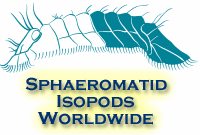| Abstract |
The early separation of Gondwana and the subsequent isolation of Antarctica caused a long evolutionary history of its fauna. Both, long environmental stability over millions of years and habitat heterogeneity, due to an abundance of sessile suspension feeders on the continental shelf, favoured evolutionary processes of "preadapted" taxa, like for example the Peracarida. This taxon performs brood protection and this might be one of the most important reasons why it is very successful (i.e, abundant and diverse) in most terrestrial and aquatic environments, with some species even occupying deserts. The extinction of many decapod crustaceans in the Cenozoic might have allowed the Peracarida to find and use free ecological niches. Therefore the palaeogeographic, palaeoclimatologic, and palaeo-hydrographic changes since the Palaeocene (at least since about 60 Ma ago) and the evolutionary success of some peracarid taxa (e.g. Amphipoda, Isopoda) led to the evolution of many endemic species in the Antarctic. Based on a phylogenetic analysis of the Antarctic Tanaidacea, Sieg (1988) demonstrated that the tanaid fauna of the Antarctic is mainly represented by phylogenetically younger taxa, and data from other crustacean taxa led Sieg (1988) to conclude that the recent Antarctic crustacean fauna must be comparatively young. His arguments are scrutinized on the basis of more recent data on the phylogeny and biodiversity of crustacean taxa, namely the Ostracoda, Decapoda, Mysidacea, Cumacea, Amphipoda, and Isopoda. This analysis demonstrates that the origin of the Antarctic fauna probably has different roots: an adaptive radiation of descendants from old Gondwanian ancestors was hypothesized for the isopod families Serolidae and Arcturidae, an evolution and radiation of phylogenetically old taxa in Antarctica could also be shown for the Ostracoda and the amphipod family Iphimediidae. A recolonization via the Scotia Are appears possible for some species, though it is not very likely (some Isopoda, like the Sphaeromatidea, are widely distributed in the Subantarctic, but rare in the high Antarctic). However, it could also be that the species of this family and others were not able to survive when the ice reached the sublittoral shelf in the high Antarctic during glacial periods. |

















